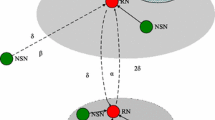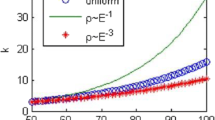Abstract
Complex network theory is used for depicting and investigating structures and functions of natural and artificial social networks or systems. Current state-of-the-art research is limited to either modeling Wireless Sensor Networks (WSNs) under some energy constraint or assuming fixed/static network model. However, WSNs is a dynamic social network, it should be an evolution network, and time of the sensor nodes adding to the network cannot be uniform. In this paper, we try to explore the Poisson dynamics of WSNs based on complex network theory combined with fitness function. Early works have not considered the node energy, we present a new Poisson-fitness model. Then we conduct theoretical analysis by using statistical physics approach. With numerical simulations, the results show that the model fits well with expect goals. Our results offer important references on the performance issues depending on specific application scenarios of WSNs.









Similar content being viewed by others
References
Barabási AL, Albert R (1999) Emergence of scaling in random networks. Science 286(5439):509–512
Bianconi G, Barabási AL (2001) Bose-einstein condensation in complex networks. Phys Rev Lett 86(24):5632
Guidoni DL, Mini RA, Loureiro AA (2010) On the design of resilient heterogeneous wireless sensor networks based on small world concepts. Comput Netw 54(8):1266–1281
Jiang N (2014) Wdem: Weighted dynamics and evolution models for energy-constrained wireless sensor networks. Phys A Stat Mech Appl 404:323–331
Jiang N, Guo Y, He Y (2014) A local-world evolving model for wsns with the self-regulating attractiveness. J Netw 9(7):1790–1797
Kamapantula BK, Abdelzaher A, Ghosh P, Mayo M, Perkins EJ, Das SK (2014) Leveraging the robustness of genetic networks: a case study on bio-inspired wireless sensor network topologies. J Ambient Intell Humaniz Comput pp 1–17
Li S, Li L, Yang Y (2011) A local-world heterogeneous model of wireless sensor networks with node and link diversity. Phys A Stat Mech Appl 390(6):1182–1191
Li-Jun C, Dao-xu C, Li X, Jian-nong C, (2007) Evolution of wireless sensor network. In: Wireless Communications and Networking Conference, (2007) WCNC 2007. IEEE, IEEE, pp 3003–3007
Liu Y, Yj Zhan, Chen J, Mo B, Dong W, Chen C, Bu JJ, Wang Q, Chen Y, Li M et al (2014) An integrated approach to sink and sensor role selection in wireless sensor networks: Using dynamic programming. Ad Hoc Sens Wirel Netw 21(3–4):177–199
Nardis L, Benedetto M (2006) The small world routing strategy: a methodological framework for driving the emerging topology of energy-constrained multi-hop wireless networks. In: Proceedings of the IEEE Radio and Wireless Symposium, California: IEEE 599402
Ross SM (2014) Introduction to probability models. Academic press
Saukh O, Hasenfratz D, Thiele L (2014) Route selection for mobile sensor nodes on public transport networks. J Ambient Intell Humaniz Comput 5(3):307–321
Sharma G, Mazumdar R (2005) Hybrid sensor networks: a small world. In: Proceedings of the 6th ACM international symposium on Mobile ad hoc networking and computing, ACM, pp 366–377
Shiva Prakash T, Raja KB, Venugopal KR, Iyengar S, Patnaik L (2014) Base station controlled adaptive clustering for qos in wireless sensor networks. IJCSNS 14(2):1
Tang L, Lu Ja WuX, Lü J (2013) Impact of node dynamics parameters on topology identification of complex dynamical networks. Nonlinear Dyn 73(1–2):1081–1097
Van Mieghem P (2014) Performance analysis of complex networks and systems. Cambridge University Press
Watts DJ, Strogatz SH (1998) Collective dynamics of small-world-networks. Nature 393(6684):440–442
Zhu H, Luo H, Peng H, Li L, Luo Q (2009) Complex networks-based energy-efficient evolution model for wireless sensor networks. Chaos Solitons Fractals 41(4):1828–1835
Acknowledgments
This work is supported by National Natural Science Foundation of China under Grant No. 41402290, No. 61462028 and No. 81460275; Young Foundation of Humanities and Social Sciences of MOE (Ministry of Education in China) under Grant No. 11YJCZH160; Key Projects in the Science and Technology Pillar Program of Jiangxi Province of China under Grant No. 20111BBG70031-2 and 20133BBE50033; Educational Commission of Jiangxi Province of China under Grant No. GJJ13335 and GJJ13354; and Foundation for Young Scientists of Jiangxi Province of China under Grant No. 20133BCB23016 and Innovation Special Funds Projects for Graduate Students of Jiangxi Province under Grant No. YC2013-X009.
Author information
Authors and Affiliations
Corresponding author
Rights and permissions
About this article
Cite this article
Jiang, N., Li, F., Wan, T. et al. PDF: poisson dynamics in fitness evolution model for wireless sensor networks . J Ambient Intell Human Comput 5, 919–927 (2014). https://doi.org/10.1007/s12652-014-0249-4
Received:
Accepted:
Published:
Issue Date:
DOI: https://doi.org/10.1007/s12652-014-0249-4




